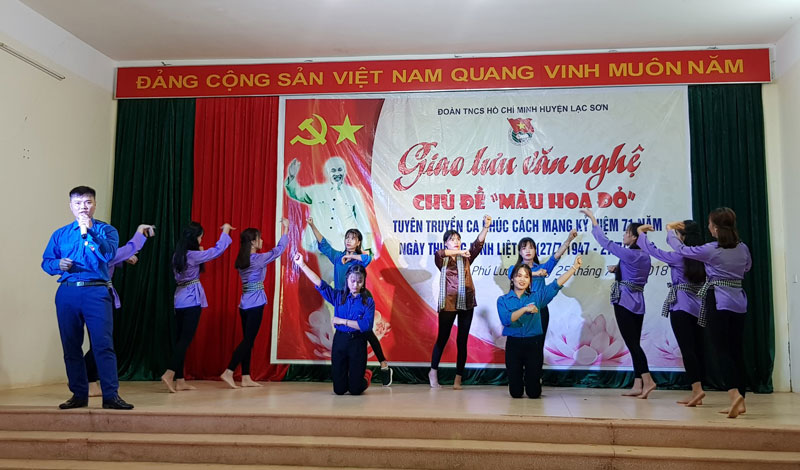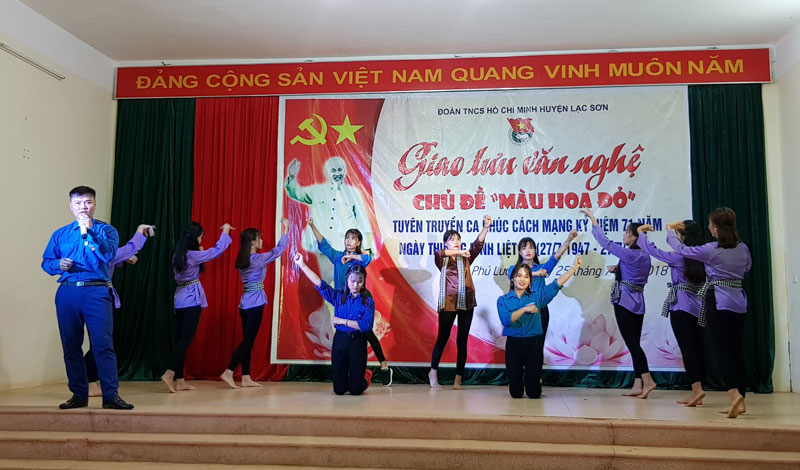
(HBO) - On the occasion of the 71st anniversary of the Invalids and Martyrs Day (27/7/1947 - 27/7/2018), in the evening of July 25th 2018, in Phu Luong Commune, The Youth Union of Lac Son District already organized the artistic exchange program with the theme of "Màu hoa đỏ”, which propagated revolutionary songs to mark the 71th anniversary of the Invalids and Martyrs Day and welcomed the youth members and people of Quyet Thang area to watch and cheer up.

A special performance in the exchange event
At the night of the exchange event, the Youth
Union members of Quyet Thang Commune brought nearly 20 special cultural
performances with the theme of praising the Party, Uncle Ho, expressing the
love for the homeland, praising those who sacrificed for the independence,
freedom of the Fatherland, praising the Youth Union organizations, etc. In
particular, there were many performances expressing the bold cultural identity
of Muong ethnic minority and the heroic Lacs Son homeland.
The cultural exchange program is a chance for
the younger generation of Lac Son district to revise the national heroic
tradition, expressing gratitude to the heroic sacrifices of heroes and
heroines, invalids and martyrs, Vietnamese heroic mothers, sick soldiers who
all have brought independence, freedom and peace for our today. On this
occasion, the Standing Committee of Lac Son District donated 05 gifts valued at
1.5 million VND to the families of Phu Luong commune's policy beneficiaries.
With an increasingly vibrant and widespread emulation movement aimed at building cultured residential areas and cultured families, Yen Thuy District has been making steady progress toward improving both the material and spiritual well-being of its people, while fostering a civilized, prosperous, beautiful, and progressive community.
Once lacking recreational spaces and community facilities, Residential Group 2 in Quynh Lam Ward (Hoa Binh City) has recently received attention for the construction of a new, spacious, and fully equipped cultural house. The project followed the model of state support combined with public contributions in both labor and funding.
The "All people unite to build cultural life" movement, which has been effectively integrated with Kim Boi district’s socio-economic development goals, is fostering a lively spirit of emulation across local residential areas, hamlets, villages, public agencies, and enterprises. In addition, through the initiative, traditional cultural values are being preserved and promoted, while community solidarity and mutual support in poverty reduction and economic development are being strengthened.
A working delegation of the Hoa Binh provincial People’s Committee led by its Permanent Vice Chairman Nguyen Van Toan on June 11 inspected the progress of a project to build the Mo Muong Cultural Heritage Conservation Space linked to tourism services in Hop Phong commune, Cao Phong district.
Born and growing in the heroic land of Muong Dong, Dinh Thi Kieu Dung, a resident in Bo town of Kim Boi district, in her childhood was nurtured by the sweet lullabies of her grandmother and mother. These melodies deeply imprinted on her soul, becoming an inseparable part of her love for her ethnic group's culture. For over 20 years, this love for her hometown has driven Dung to research, collect, and pass down the cultural values of the Muong people to future generations.
In the final days of May, the Ethnic Art Troupe of Hoa Binh Province organized performances to serve the people in remote, mountainous, and particularly disadvantaged areas within the province. These were not just ordinary artistic shows, but they were the meaningful journeys aimed at spreading cultural values, enhancing the spiritual life of the people and contributing to the preservation of ethnic minority cultural identities.



